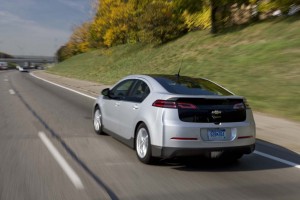General Motors is moving quickly to protect the reputation of the Chevrolet Volt in the wake of a new government investigation looking at possible safety problems involving the maker’s high-profile plug-in hybrid.
In the wake of several fires involving Volt battery packs used in crash tests by the National Highway Traffic Safety Administration, GM says it will provide loaner vehicles to Volt owners concerned about safety while the investigation gets underway.
The NHTSA announced this week it was opening a formal investigation into why a Volt caught fire following a NHTSA-run crash test last spring, with an additional Volt battery pack igniting earlier this month after further crash tests.
“The Volt is our pride and joy and we will do all we can to make Volt owners just as proud and happy with it as we are,” GM North America President Mark Reuss said Monday during a news conference.
The federal safety agency advised GM on Friday it was opening a preliminary evaluation of Volt battery assemblies after NHTSA test results caused electrical fires up to three weeks after an initial vehicle New Car Assessment Program side pole crash test last May.
“We at GM take enormous pride in Volt and what it represents – which is a new era of extended-range electric vehicles that can lessen our dependence on petroleum, reduce our emissions, and much more, all while carrying the U.S. and European regulatory authorities’ highest safety ratings,” added Reuss. That’s why we will take every precaution to assure the driving public of our commitment to the safety of the Volt, and to the total satisfaction of everyone who owns one.”
The executive added that, “Our customers’ peace of mind is too important to us for there to be any concern or any worry. This technology should inspire confidence and pride, not raise any concern or doubt.”
Mary Barra, GM’s global product development chief, said the maker had established a senior engineering team to develop changes to eliminate concern of potential post-crash electrical fires and work with the rest of the industry to ensure appropriate electric vehicle protocols are put in place. Barra stressed such electrical fires had not occurred on public roads and NHTSA had not heard of any such failures with Volts now in customer hands.
“GM and the agency’s focus and research continue to be on the performance, handling, storage and disposal of batteries after a crash or other significant event,” she said. “We’re working with NHTSA so we all have an understanding about these risks and how they can be avoided in the future. This isn’t just a Volt issue. We’re already leading a joint electric vehicle activity with Society of Automotive Engineers and other automotive companies to address new issues, such as this protocol of depowering batteries after a severe crash,” Barra said.
Earlier this month – before the second Volt battery fire was revealed – GM suggested that the initial incident was the result of a failure to follow post-crash protocol. While NHTSA researchers drained the gas tank after the crash test they left the damaged vehicle sitting outdoors with a charged-up battery. It appears that over time the battery’s liquid coolant crystallized and eventually caused a short that, in turn, led to the fire.
GM plans to begin supplying a new tool to first responders and others who might store Volts after an accident that can “de-energize” the vehicles battery, reducing a risk of fire.
Barra noted GM carried out more than 1 million test miles in the development of the Volt. That effort has included tests in Europe to which GM has begun to export the Volt in the form of the Opel Ampera. GM also has announced plans to distribute the Volt in China beginning next years.
Concerned some drivers now may be worried about driving their Chevy Volt, Reuss said GM planned to establish an owner satisfaction program. Any Volt owner concerned about safety can contact his or her sales advisor to arrange for a free GM vehicle loan until resolution of the issue.
“A vehicle loan program of this nature is well beyond the norm for a preliminary investigation, and it underlines our commitment to the vehicle and its owners,” he said. “These steps are the right ones to take regardless of any immediate impact on our operations.”


This is just so discouraging. I don’t believe in any way that GM has been irresponsible with the Volt, and certainly taking a hit now is better than stalling; just ask Toyota. But in today’s “advocacy journalism world” dominated by cable “news” and AM radio talkers, the mud is going to be slung, and the “Government Motors” types are going to make a certain amount of it stick, no matter what GM does. My local newspaper even had an article by a Susan Stamper Brown, whoever she is, tying Obama, GM, the Volt into an attempt to promote cap-and- trade legislation, saying the Volt was a product of the Obama administration (it may have first been sold under Obama, but it certainly was a concept car under Bush and the first working model was previewed under Bush), saying that the federal tax credit was reduced the cost of the Volt, the cost of which ranged from $42,000 to $57,000 in price, and that the Volt nearly burned down a house in North Carolina when the battery overheated, something that I haven’t seen reported. And I live in a GM town! Like I said, very discouraging.